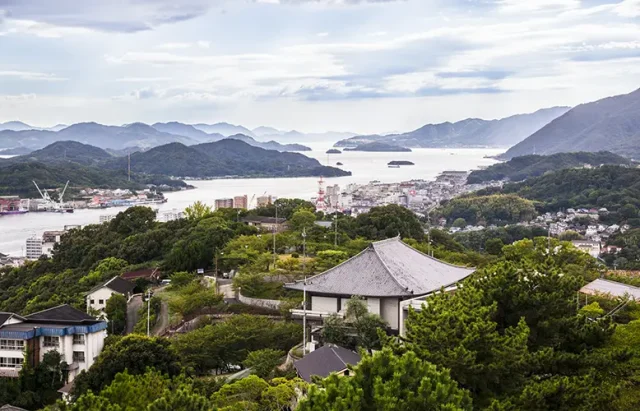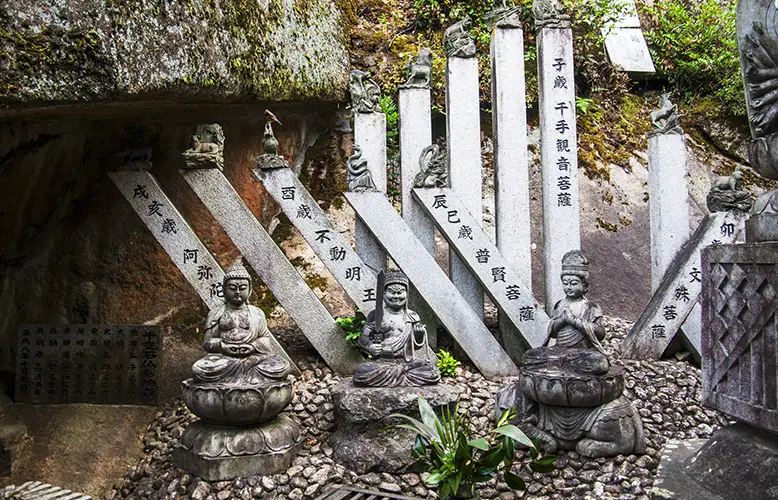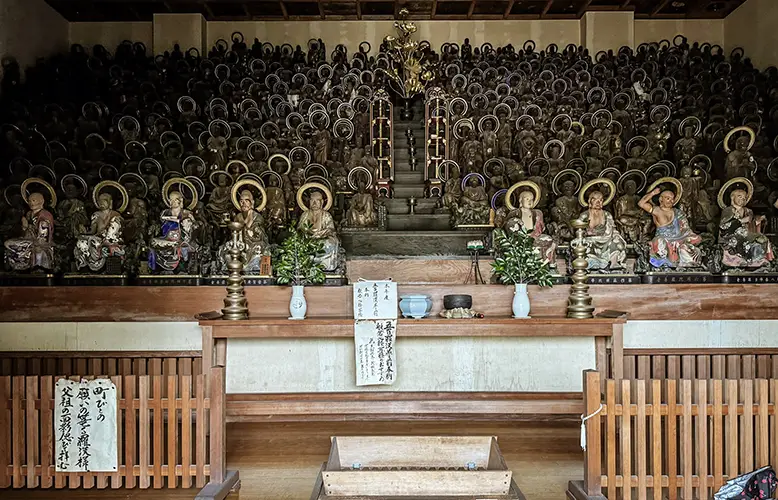
The Setouchi region of Japan is captivating travelers with its variety of hidden-gem destinations that reveal the country’s rich culture. Among these treasures lies Hiroshima Prefecture, a destination that blends its storied past, vibrant cultural scene, and distinctive cuisine. Beyond its historical significance, Hiroshima is home to lesser known sites waiting to be explored—from charming alleyways filled with local art and culture to culinary havens that celebrate the region’s unique flavors.
Onomichi City, located in the southeastern part of Hiroshima Prefecture, is a treasure trove of cultural experiences that go beyond the ordinary. With its blend of historic temples, artistic alleyways, and innovative spaces, this charming city offers visitors a deeper understanding of the region’s cultural tapestry:

- Senkoji Temple –Founded in 806 by the monk Kobo Daishi, founder of the Shingon sect of Buddhism which emphasizes enlightenment through the chanting of special words, Senkoji Temple is a historic and cultural landmark in Onomichi. Senkoji can be reached via the Senkoji Ropeway and then a five minute walk along the promenade. Once there, visitors can explore the temple grounds and a variety of activities. One of the best highlights of the visit comes upon reaching the Senkoji PEAK Observatory, where you can see the beauty of the city, a Japanese Heritage site, and the narrow channel between Onomichi, a port town facing the Seto Inland Sea, and Mukojima on the other side of the sea. Starting from the Senkoji Ropeway summit station, visitors can first take in the panoramic views from the Senkoji PEAK Observatory. As they descend along the Bungakuno-komichi, or “Literary Path,” they’ll discover stone monuments inscribed with poems and writings by renowned Japanese literary figures, before arriving at the historic Senkoji Temple.This pathway adds a reflective, intellectual layer to the visit, allowing guests to connect with the literary history that has been inspired by the landscapes of Onomichi. The temple grounds are filled with surprising elements, including adorable Rilakkuma-themed ema (votive tablets) and omikuji (fortune slips). Rilakkuma is a popular Japanese character, known as the “relaxed bear.”
- Tenneiji Temple – Tenneiji Temple is a Soto Zen temple located in Onomichi city, Hiroshima prefecture. It was founded in 1367 and is part of the Soto school, part of the sect of Buddhism, which emphasizes mental discipline through the practice of seated meditation. The three-story pagoda, the symbol of the temple, was originally built in 1388 as a five-story pagoda, but in 1692, due to aging, the upper two stories were removed to make way for the present three-story pagoda. The temple is also known for its symbolic three-story building. It is now designated as a National Important Cultural Property and enshrines Miroku Bosatsu. A person who aspires to become a Buddha, the highest attainment of Buddhist faith, is called a Bosatsu, and the highest of these Bosatsu is called Miroku Bosatsu. Visiting Tenneiji starts with a pleasant 15-minute walk from Onomichi Station through the charming Hondori Shotengai, lined with local shops, cafes, and restaurants. One of the temple grounds’ most unique features is the Gohyaku Rakan—a collection of 526 stone statues representing the Buddha’s disciples, each with a distinctive expression and posture, offering deep insights into Buddhist teachings.
- Narrow Cat Trail – Narrow Cat Trail, also known as Neko no Hosomichi, is a charming 200-meter alley in Onomichi that has become a beloved destination for cat lovers and art enthusiasts. Adorned with whimsical “Fukuishi Neko” (cats painted on round stone) created by artist Shunji Sonoyama, the alley is a visual delight. Cafés, museums, and traditional stores dot the area, making it an ideal place to enjoy a leisurely walk while discovering Onomichi’s quaint charm.
- LOG – LOG is a modern, multi-purpose facility nestled on a hillside overlooking the Onomichi cityscape. A collaboration with the Indian architectural collective Studio Mumbai, LOG reimagines a 1960s apartment building into a vibrant space featuring a café, restaurant, bar, gallery, and accommodations. Its use of traditional Japanese paper and locally sourced cuisine create a unique destination.
For travelers interested in the gastronomic side of Hiroshima prefecture, there’s no better place to savor the region’s cuisine than Okonomimura. Located in Naka-ku, Hiroshima City, Okonomimura is a lively destination that brings together 23 okonomiyaki restaurants under one roof. Originating as a collection of post-war food stalls, Okonomimura has transformed into a multi-level gastronomic hub where visitors can enjoy authentic Hiroshima-style okonomiyaki, prepared right in front of them on a teppan grill. The interactive cooking experience, friendly atmosphere, and flavorful dishes make Okonomimura a must-visit spot for those eager to savor Hiroshima’s local specialties.

At Tetsu on the second floor, the energetic staff create a lively and fun ambiance, engaging with customers while skillfully preparing Hiroshima-style okonomiyaki right in front of them on a teppan grill. Sitting around the teppan allows visitors to fully experience the culinary process, making it an especially enjoyable experience for those passionate about Japanese gastronomy. For international visitors, the restaurant offers an English menu and a helpful infographic detailing the layers of Hiroshima okonomiyaki and the preparation process. Popular dishes include the tetsu yaki, featuring squid tempura and green onions, and buchi nikutama, which comes with double pork and an egg. The combination of delicious food, engaging staff, and the authentic cooking experience makes dining at Tetsu a highlight of any visit to Okonomimura.
For authentic Japanese history, culture, and cuisine, Hiroshima Prefecture is a destination that should not be missed. With its rich culinary traditions, historic temples, and charming artistic enclaves, the region offers a variety of authentic experiences that go beyond the typical tourist path.
For those seeking a deeper understanding of Setouchi’s unique offerings, the Setouchi Destination Marketing Organization (DMO) provides tailored travel itineraries and insider tips. From culinary tours to historical explorations, Setouchi DMO helps visitors plan memorable experiences that go beyond conventional destinations. For inspiration on travel itineraries throughout the Setouchi region, visit Setouchi Travel.





